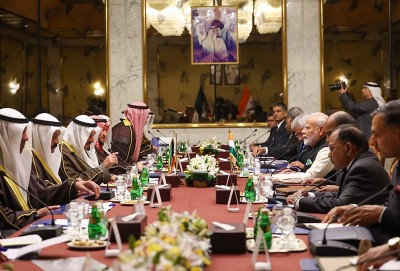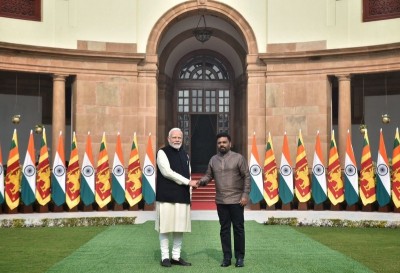
India has huge potential to become the leader in Solar Energy sector: Vice President Naidu
New Delhi, Mar 10 (IBNS): Vice President of India M. Venkaiah Naidu has said that India has huge potential to become the leader in solar energy sector.
He was addressing the inaugural session of ELECRAMA 2018, organized by the Indian Electrical and Electronics Manufacturing Association, in Noida, UP on Saturday.
The Union Minister for Commerce & Industry,Suresh Prabhakar Prabhu and other dignitaries were present on the occasion.
The Vice President said that the Indian Electrical Equipment Industry consists of generation, transmission, distribution and allied equipment and this industry provides direct employment to 5 lakh persons, indirect to 10 lakh others and over 50 lakhs across the entire value chain.
He further said that this industry is facing stiff competition from imports and is seeking the creation of a level playing field for the domestic industry.
"I am sure the power sector will rise to occasion and ensure that the quality of international standards," he added.
The Vice President said that various initiatives taken by the government have improved India’s rank in World Bank’s Ease of Getting Electricity Index from 99 to 26.
At the end of December 2017, only 1370 villages remained to be electrified out of 18, 452 un-electrified villages, he added.
The Vice President said that global warming and climate change are affecting every aspect of our life and any new policy has to factor in the urgent need to protect environment and ensure sustainable development.
He further said that with India ranking second in Renewable Energy Attractive Index 2017, this sector is bound to play a major role in the years ahead.
"Energy storage technologies are needed not only to create more resilient infrastructure but also to bring down costs," he added.
The Vice President said that electric vehicles and hybrid electric vehicles will be driving the automobile industry in the coming years.
He further said that the government had already unveiled the National Electric Mobility Mission Plan and set a target of 6-7 million units of Electric Vehicles and hybrid electric vehicles by 2020.
"In a bid to reduce carbon dioxide emissions, a major thrust is being given to e-vehicles," he added.
Following is the text of Vice President’s address:
“I am delighted to inaugurate ELECRAMA-2018, the Indian Electrical and Electronics Manufacturing Association’s flagship event showcasing the electricity industry’s ecosystem. I thank IEEMA and those seated on the dais for the warm welcome extended to me.
I compliment IEEMA for organizing this five-day event to showcase not only the existing technology but also to focus on future solutions for the power sector. That is the way forward as rapid advancements in various technologies and the digital revolution are changing our lives like never before. With IEEMA members representing a combined annual turnover in excess of USD 42 billion and having contributed to more than 95 per cent of the power equipment in India, I am sure you are all geared up to meet the future needs of the country.
The Indian Electrical Equipment Industry consists of generation, transmission, distribution and allied equipment. The industry production for 2016-17 has been estimated to be at Rs.1,52,000 crore, exports at Rs.39, 280 crore ( about US$ 6 Billion) and imports at Rs. 55,290 crore (US $ 8.5 billion). I am told that the industry provides direct employment to 5 lakh persons, indirect to 10 lakh others and over 50 lakhs across the entire value chain.
I am aware that the Indian electrical industry is facing stiff competition from imports and is seeking the creation of a level playing field for the domestic industry. I am told that a holistic Mission Plan launched by the Government with the support of IEEMA lays down a clear roadmap for enhancing the competitiveness of the domestic electrical equipment industry. At the same time, I am sure the power sector will rise to occasion and ensure that the quality of international standards is maintained for providing uninterrupted power at affordable prices.
Various initiatives taken by the government have improved India’s rank in World Bank’s Ease of Getting Electricity Index from 99 to 26. At the end of December 2017, only 1370 villages remained to be electrified out of 18, 452 un-electrified villages.
As envisaged in ‘Vision 2022’, I urge upon all stakeholders to strive towards making India the country of choice for the production of electrical equipment and reach an output of US $ 100 billion by balancing exports and imports.
As you all are aware, India has regained the economic momentum and became the fastest growing economy by registering a GDP growth rate of 7.2 per cent in the last quarter. India is projected to become the third largest economy in the world in the next 15 years and the need of the hour is to not only keep up the momentum but to accelerate the growth rate as well. The electrical and electronics industry has a vital role to play in the overall growth architecture of the economy.
Today global warming and climate change are affecting every aspect of our life and any new policy has to factor in the urgent need to protect environment and ensure sustainable development. With India becoming an attractive renewable energy market in the world, promoting clean energy is the way forward. The total installed renewable energy in India touched 62.846 GW by December 2017, around 18.8 per cent of the total energy capacity in the country.
With India ranking second in Renewable Energy Attractive Index 2017, this sector is bound to play a major role in the years ahead as the country looks to meet its energy needs.
According to data released by the Department of Industrial Policy and Promotion (DIPP), FDI inflows in the Indian non-conventional energy sector between April 2000 and September 2017 stood at US$ 6.01 billion.
Friends as you know, energy storage technologies hold the key to meet future energy needs. These technologies are needed not only to create more resilient infrastructure but also to bring down costs. Greater research is needed on energy storage systems. Various energy storage technologies include solid state batteries, flow batteries, compressed air energy, thermal and pumped hydro power.
As far as solar energy is concerned, the national solar mission has been launched to harness its full potential as part of meeting the country’s energy security. India has huge potential to become the leader in this area. Solar parks and solar plants have to be established to ensure that solar energy reaches even the remotest corners in the country.
As you all are aware, electric vehicles and hybrid electric vehicles will be driving the automobile industry in the coming years. The government had already unveiled the National Electric Mobility Mission Plan (NEMMP) and set a target of 6-7 million units of Electric Vehicles (EVs) and hybrid electric vehicles by 2020.
In a bid to reduce carbon dioxide emissions, a major thrust is being given to e-vehicles. The potential for use of environmental-friendly electric vehicles, including hybrid technologies in the country, is vast and has to be fully tapped.
The other advantages of e-vehicles, include lower operating costs and reduced dependence on fossil energy. Of course, a major thrust has to be given for vehicle-charging infrastructure. The ensuing demand for EV battery production will provide a huge opportunity for the domestic manufacturing industry. The demand for EV batteries manufacturing domestically will also create several jobs within the country.
The switching over to hybrid and electric vehicles is imperative in view of the growing fuel import bill, which is expected to touch a whopping $ 300 billion by 2030.
I am sure that the five-day event will cover every aspect relating to electronics and electrical industry and come out with recommendations for meeting future energy needs through greener and sustainable technologies.
Thank you. Jai Hind!”
Support Our Journalism
We cannot do without you.. your contribution supports unbiased journalism
IBNS is not driven by any ism- not wokeism, not racism, not skewed secularism, not hyper right-wing or left liberal ideals, nor by any hardline religious beliefs or hyper nationalism. We want to serve you good old objective news, as they are. We do not judge or preach. We let people decide for themselves. We only try to present factual and well-sourced news.







